When the US went to the first World Cup in 1930, 16 players were on the roster, unlike the 23 that are on the roster for 2010. In 1930, there were only five extra players available largely because substitutions were not allowed: you started with 11 players and if one of them was injured during the course of a match and couldn’t continue, you played on without him.
There are always those bizarre exceptions. For example, the French keeper Alex Thépot was substituted in 1930 World Cup after being kicked in the head by a Mexican player. But this seems to have been unofficially allowed for in the same tournament US keeper Jimmy Douglas was injured when he was intentionally fouled by an Argentinian player. Barely able to stand up, let alone move, Douglas had to continue on. It was not until the 1958 World Cup that FIFA officially allowed substitutions and only then for one injured goalie and one injured field player. It was not until the 1970 World Cup that FIFA officially allowed three substitutions for tactical reasons as well as for injuries.
For the US in 1930, 1934 and 1950, extra players were on the roster in case of a catastrophic injury among the relatively fixed starting 11. Philadelphia’s own James Gentle, one of the 16 players on the roster in 1930, seems to have been chosen largely because he spoke Spanish: he didn’t play a minute in the tournament.
Things are of course different now and this is reflected in the size of team’s rosters. In the 2002 World Cup, for example, Bruce Arena started 16 players, using a different lineup for each of the five games the US played, both because players were injured and for tactical reasons. For the same reasons, it’s very likely that we’ll see a different lineup from the one that Bob Bradley picked to face England through the course of the group stages.
Part of the fun of watching the World Cup is talking about great moments and players from the past. While the record of the US at the World Cup, like that of most countries who have played in it, is not as memorable as many of us would like, the history of the US at the World Cup is full of players worth remembering.
The question is, are there enough of them to build a truly great World Cup team?
Below is a 30 player roster for a All-World Cup US team and my reasons for including each player. It’s up to you to whittle it down to a final 23.
Anyone on the 2010 US World Cup squad who hasn’t played in a previous World Cup is not included. With that in mind, if you think someone should have been included on the 30-player list, sound off in the comment area. But when you do so, also suggest who that player should replace and why. Fair is fair, after all.
Goalkeepers (Pick 3)
I know, Tim Howard should be on this list. But, while he was on the 2006 World Cup team, he didn’t play a minute because he was behind Kasey Keller and didn’t become the first-choice goalkeeper until Bob Bradley became coach. His game against England in 2010 was truly magnificent but the injury to his ribs might mean that further playing time is limited.
Frank Borghi (1950): One of the heroes of the 1–0 victory over England, he withstood a barrage of shots to keep a clean sheet against the best team in the world. The Brazilian crowd carried him and Joe Gaetjens off the pitch on their shoulders after the win. 9 caps (There were very few opportunities to earn national team starts before the US Soccer Federation began to get its act together in preparation for qualifying for the 1990 World Cup.).
Brad Friedel (1994, 1998, 2002): Played behind Tony Meola in 1994 and Kasey Keller in 1998. “The Human Wall was an absolute monster in 2002, where he became the first goalie since 1974 to save two penalty kicks during regular play. 82 caps.
Kasey Keller (1990, 1994, 1998, 2002): Like Meola, he was a stalwart on the US team and one of a wave of US goalkeepers to find success internationally in club play. Had the misfortune to be the starting keeper in the terrible showings of the US team at the 1998 and 2006 World Cups. 102 caps.
Tony Meola (1990, 1994, 1998, 2002): While never a success internationally in club play, he kept a clean sheet in the 1–0 victory over Trinidad and Tobago and played every minute for the US in the 1994 World Cup, until 2002 the best performance by the US since 1930. 100 caps.
Defenders (Pick 7)
The obvious choices start showing up in 1994 because, let’s face it, the US defense let goals in like a sieve in 1934, 1950 and 1990. Come to think of it, it wasn’t so great in 1998 and 2006 either.
Marcelo Balboa (1990, 1994, 1998): One of the most capped players in soccer history, Balbao played in all three US matches in 1990—including two starts—and played every minute in 1994. Steve Sampson played him a total of nine minutes in 1998. A defender with a habit of finding the net. 128 caps and 13 goals.
Carlos Bocanegra (2006, 2010): Played two matches in 2006 at left back, the current US captain is a proven leader. 80+ caps and 12 goals and counting.
Paul Caligiuri (1990, 1994): Scored the goal in the final match of qualification for 1990 to put the US in the World Cup for the first time since 1950, Caligiuri scored the first US goal since 1990 and started in every match for the US in the 1990 and 1994 World Cups. 110 caps and five goals.
Thomas Dooley (1994, 1998): Played every minute of the 1994 World Cup and started every match in 1998 where he was the US captain. 81 caps and 7 goals.
Frankie Hejduk (1998, 2002): Two starts in 1998 and four starts in 2002, he can play on the right or the left. 85 caps and 7 goals.
Harry Keough (1950): He was everywhere in the match against England in 1950. 17 caps and 1 goal.
Alexi Lalas (1994, 1998): A standout in 1994, he later found some success playing in Italy. Selected for the 1998 team, he did not play a single minute. Now makes his living as a blowhard. 96 caps and 9 goals.
George Moorehouse (1930): A versatile utility player with experience playing left wing and a knack for carrying the ball up field to create dangerous scoring chances. 7 caps.
Oguchi Onyewu (2006, 2010): Started in all three matches in 2006, his disputed foul in the closing minutes of the last game against Ghana gave them the game winner. A towering presence who, against expectation, played all 90 minutes against England in 2010. 50+ caps and 5 goals and counting.
Eddie Pope (1998, 2002): Two starts in 1998 and five starts in 2002. Would have had three starts in 2006 but for a dubious red card in the match against Italy. 82 caps and 8 goals.
Midfielders (Pick 9)
Things start to get little more difficult here, I think.
Walt Bahr (1950): His shot led to Joe Gaetjens goal to give the US the 1–0 victory over England in 1950. The Philadelphia-native was captain of the 1950 US team and widely considered to be the greatest player of his generation. 18 caps and 1 goal.
DaMarcus Beasley (2002, 2006, 2010): With three starts in the 2002 World Cup group stages, Beasley was the target of criticism along with Landon Donovan for poor performance in 2006. Against expectation, fought his way onto the 2010 team. 92 caps and 17 goals and counting.
Clint Dempsey (2006, 2010): Scored the only US goal of 2006 with an assist from Beasley, and the first goal for the US in 2010, Dempsey has shown a knack for the dramatic goal. 60+ caps and 19 goals and counting.
Landon Donovan (2002, 2006, 2010): A star in 2002—where he scored against Poland and Mexico—and a goat in 2006, he is now determined to claim his place in world soccer. 42 goals with 120+ caps and counting.
Thomas Florie (1930, 1934): Scored in 1930, one of the outstanding US midfielders of the 1930s. 8 caps and 2 goals.
Billy Gonsalves (1930, 1934): “The Babe Ruth of American soccer,” this versatile player made a dangerous combination with Bert Patenaude as a forward in 1930 and was a threat as a center half in 1934. The recipient of many offers to play in Europe after 1934, he returned to America instead. 6 caps and 1 goal.
John Harkes (1990, 1994): One of the new wave of American players capable of finding success abroad, Harkes played in every group stage match in 1990 and 1994 but missed the Round of 16 match against Brazil because of suspension. The “Captain for Life” was not selected for the 1998 team because of “leadership issues,” e.g. sleeping with a teammate’s wife. 90 caps and 6 goals.
Cobi Jones (1994, 1998, 2002): Three appearances and a start against Brazil in 1994. Played every minute in 1998. Four appearances in 2002. The all-time US cap leader with 164 caps and 15 goals.
Tab Ramos (1990, 1994, 1998): A starter in every match in 1990 and 1994, played in two matches in 1998 including one start. 81 caps and 8 goals.
Claudio Reyna (1994, 1998, 2002, 2006): Selected for 1994 but did not play due to injury. Played every minute in 1998. Missed the first match in 2002 but started the next four games as captain. The only American other than Bert Patenaude to be named to a World Cup all-tournament team. Captain again in 1996 until injured in last match against Ghana. 112 caps and 8 goals.
Earnie Stewart (1994, 1998, 2002): Three starts as a forward in 1994. Moved to midfield where he had three appearances including two starts in 1998 and five appearances including two starts in 2002. Susceptible to the red card. 101 caps and 17 goals.
Forwards (Pick 4)
The US has always been weak in the killer forward department, but this selection should give some food for thought.
Aldo “Buff” Donnelli (1934): An unknown when selected for the 1934 squad, he scored all four goals against Mexico in the special qualifier played in Rome and the only goal against Italy in the 7–1 loss. 2 caps and 5 goals.
Joe Gaetjens (1950): Scored the winning goal against England in 1950. Walt Bahr has said Gaetjens could score from anywhere. 3 caps and 1 goal.
Brian McBride (1998, 2002, 2006): Second behind Patenaude for goals scored at the World Cup, McBride is the first US player to score in two World Cups with one goal in 1998 and 2 in 2002. Fearless. 95 caps and 30 goals.
Joe-Max Moore (1994, 1998, 2002): Selected in 1994 but did not play. Two starts in 1998, two appearances in 2002. 100 caps and 24 goals.
Bert Patenaude (1930): Scored four goals including the first hat trick in World Cup history. Also had two assists. 4 caps and 6 goals.
Eric Wynalda (1990, 1994, 1998): Two games with one start in 1990. Four games with three starts and one goal in 1994. Two games with one start in 1998. 106 caps, 34 goals.
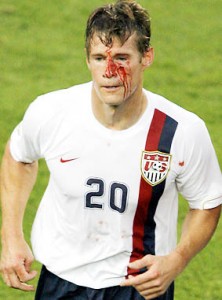
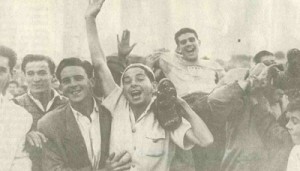

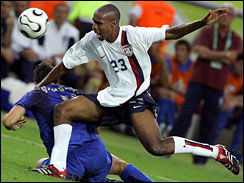
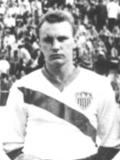
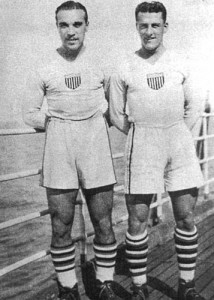

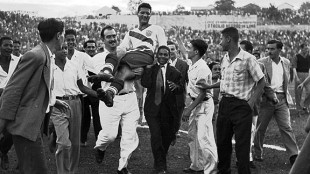

Alex Thepot wasn’t substituted. He was replaced in goal by team mate Augustin Chantrel, leaving France with ten men for the last hour.
All the best,
Cris Freddi
I’m astonished at the omission of the striker John “Clarkie” Souza. He was a starter for the U.S. team in all three of their games in the 1950 World Cup — and the Brazilian sports newspaper Mundo Esportivo selected him for its World Cup All-Star team. He remained the only American player ever selected to a World Cup All-Star team until Claudio Reyna, in 2002.
¶
Souza was also on the 1948 and 1952 U.S. Olympic teams. His clubs were Ponta Delgada, of Fall River, Mass., and the New York German-Hungarians. Each team won multiple trophies during his years with them. Walter Bahr still says that Clarkie may have been the most skilled American player of his generation. At the time of Clarkie’s death in 2012, Bahr mentioned that when touring European teams played American clubs or all-star teams in the late ’40s and early ’50s, Souza was the American player that they always tried to persuade to sign to play overseas. He was, however, content to stay home with his career and his family.
¶
I’d probably pull Moore or Wynalda to make room for Souza.
¶
Incidentally, Bahr, too, attracted the attention of European soccer coaches. He’s told me and my son that, when he was on squads that played the touring Europeans in New York and other cities, after the games both teams would adjourn to a nearby bar, and spend hours talking shop over beers. Bahr especially enjoyed his conversations with the legendary Manchester United manager Matt Busby. (Boy, what •I’d• have paid for a bar stool three or four feet away, to spend a couple hours eavesdropping!) And Busby actually offered Bahr a contract to play for Man U; Bahr was a little tempted, but, of course, he had a career as a teacher underway, as well as a family with children, in Philadelphia.
¶
And we need to remember that the wage for players in the English Football League First Division in the 1950s was a maximum £12 a week (£10 in summer). In that era, a top England player, playing for club and country, probably would have earned between £1,600 and £1,700 a year in wages, bonuses, and international match fees. That’s equivalent to pulling down about a £75,000 a year today. It’s not a bad living — but it’s what a top star with Man U •now• earns in about 44 hours!
¶
So, even for a preëminent American star of the era, like Walter Bahr, the incentive for going overseas in the 1950s was •far• less compelling than it would be for his successors some three, four decades and more later!
Ed, I have questions about your assertions as to the history of substitutions in the World Cup:
¶
“It was not until the 1958 World Cup that FIFA officially allowed substitutions and only then for one injured goalie and one injured field player. It was not until the 1970 World Cup that FIFA officially allowed three substitutions for tactical reasons as well as for injuries.”
¶
As best I can tell, substitutions were not permitted at •all• in the final tournament until 1970 — and then the limit was •two• per game, not three. In the qualifying stages, however, substitutions were apparently allowed as early as the 1954 Cup cycle, with the first substitution actually made in October of 1953.
¶
Do you have any source for your contention that FIFA started allowing substitutions for injured players in the 1958 Cup? I’ve haven’t found any records that would corroborate that; it would be interesting to see some source verifying such a rule.
¶
The number of fully discretionary substitutions in World Cup matches was not expanded to three until 1998. The 1994 World Cup, however, was a transitional competition for the substitution rule: in addition to the two substitutions permitted at any position, one additional substitution, restricted to the goalkeeper, was added.
I think maybe now it’s the time to take care of our environment, now that a lot of Earthquake is haipenpng our the world. We should be aware and responsible for our every move.